Khawaja Zaheer Ahmed - PDMA
Khawaja Zaheer Ahmed - PDMA
Khawaja Zaheer Ahmed - PDMA
You also want an ePaper? Increase the reach of your titles
YUMPU automatically turns print PDFs into web optimized ePapers that Google loves.
Raj, and those built since independence, are of vital importance for food and<br />
cash crops, the two main stays of the national economy with quick yielding, least<br />
input-output ratios, and largest single source of informal employment. Twelve link<br />
canals and 45 canals commands also help calm the raging flood waters from<br />
cyclical devastation of large areas. [For more details, Google may be explored].<br />
SECTION-2<br />
THE 2010 MONSOONS<br />
33. The south-west monsoons contribute some 65% of the annual rainfall in<br />
Pakistan; the rest is generated by other systems including north-westerly winds,<br />
in winter. The 2010 monsoon season was, however, unusual in some respects.<br />
In end June, 2010, the PMD’s seasonal forecast predicted ‘slightly above normal’<br />
monsoon (+10%) and weather remained dry till 17 th July. Provinces competed for<br />
extra irrigation releases for the Kharif crops till end of 3 rd week of July; between<br />
18-26 th July, moderate to high but localized rains visited the Indus basin’s<br />
catchments, though southern Pakistan received a few traces of rains, here and<br />
there. By that time, PMD had reviewed its earlier forecast in favour of heavy<br />
rainfall and alerted all concerned. Revised weather ‘Advisories’ were issued by<br />
its FFC Division, to all concerned to prepare for the eventuality. It was stated<br />
before the Punjab Judicial Commission that international forecast s of extremely<br />
high rains was not shared with the stakeholders. Beginning 27 th July, an unusual<br />
convergence of easterly NW system was noted over north western Pakistan<br />
(Khyber Pakhtunkhwa + NW Punjab), with westerly Arabian sub-tropical winds<br />
forming a static jet for almost 48 hours. That triggered an unprecedented<br />
precipitation in upper and lower Swat, especially Saidu Sharif in Malakand and<br />
upper and lower Dir, Besham and Peshawar. By 30th July, the rains had<br />
generated fierce dimensions in the form of raging floods. (Source: Daily Observer<br />
of 14-09-2010 Article by Dr. Mohammad Haneef of PMD, cited in Wapda’s<br />
power-point presentation of 15 February 2011). The precipitation was so<br />
extraordinary that some claimed its frequency of return-period at Peshawar and<br />
Page 87 of 211


